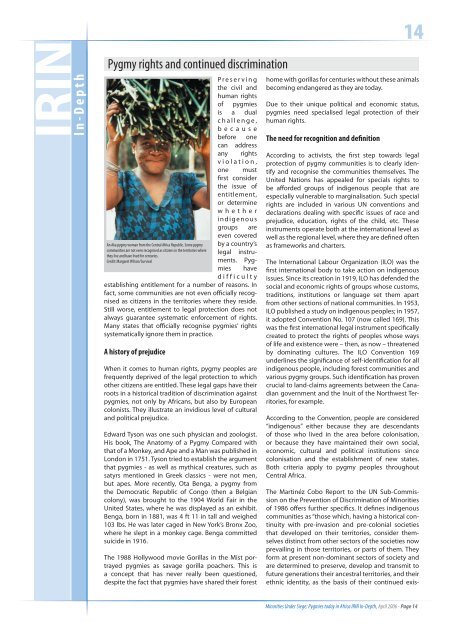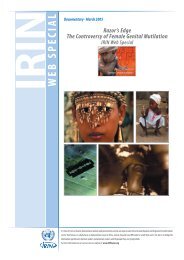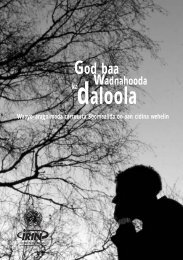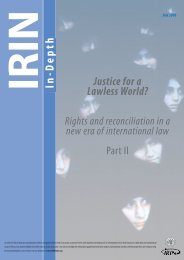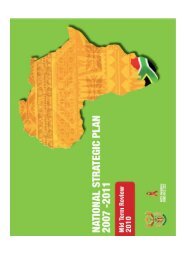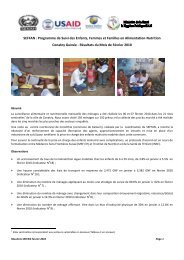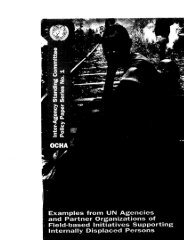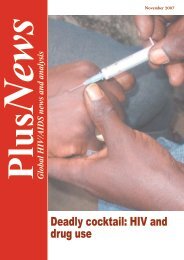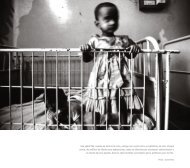Minorities Under Siege: Pygmies today in Africa - IRIN
Minorities Under Siege: Pygmies today in Africa - IRIN
Minorities Under Siege: Pygmies today in Africa - IRIN
You also want an ePaper? Increase the reach of your titles
YUMPU automatically turns print PDFs into web optimized ePapers that Google loves.
<strong>IRIN</strong><br />
I n - D e p t h<br />
Pygmy rights and cont<strong>in</strong>ued discrim<strong>in</strong>ation<br />
An Aka pygmy woman from the Central <strong>Africa</strong> Republic. Some pygmy<br />
communities are not even recognised as citizens <strong>in</strong> the territories where<br />
they live and have lived for centuries.<br />
Credit: Margaret Wilson/Survival<br />
P r e s e r v i n g<br />
the civil and<br />
human rights<br />
of pygmies<br />
is a dual<br />
c h a l l e n g e ,<br />
b e c a u s e<br />
before one<br />
can address<br />
any rights<br />
v i o l a t i o n ,<br />
one must<br />
first consider<br />
the issue of<br />
entitlement,<br />
or determ<strong>in</strong>e<br />
w h e t h e r<br />
i n d i g e n o u s<br />
groups are<br />
even covered<br />
by a country’s<br />
legal <strong>in</strong>struments.<br />
<strong>Pygmies</strong><br />
have<br />
d i f f i c u l t y<br />
establish<strong>in</strong>g entitlement for a number of reasons. In<br />
fact, some communities are not even officially recognised<br />
as citizens <strong>in</strong> the territories where they reside.<br />
Still worse, entitlement to legal protection does not<br />
always guarantee systematic enforcement of rights.<br />
Many states that officially recognise pygmies’ rights<br />
systematically ignore them <strong>in</strong> practice.<br />
A history of prejudice<br />
When it comes to human rights, pygmy peoples are<br />
frequently deprived of the legal protection to which<br />
other citizens are entitled. These legal gaps have their<br />
roots <strong>in</strong> a historical tradition of discrim<strong>in</strong>ation aga<strong>in</strong>st<br />
pygmies, not only by <strong>Africa</strong>ns, but also by European<br />
colonists. They illustrate an <strong>in</strong>vidious level of cultural<br />
and political prejudice.<br />
Edward Tyson was one such physician and zoologist.<br />
His book, The Anatomy of a Pygmy Compared with<br />
that of a Monkey, and Ape and a Man was published <strong>in</strong><br />
London <strong>in</strong> 1751. Tyson tried to establish the argument<br />
that pygmies - as well as mythical creatures, such as<br />
satyrs mentioned <strong>in</strong> Greek classics - were not men,<br />
but apes. More recently, Ota Benga, a pygmy from<br />
the Democratic Republic of Congo (then a Belgian<br />
colony), was brought to the 1904 World Fair <strong>in</strong> the<br />
United States, where he was displayed as an exhibit.<br />
Benga, born <strong>in</strong> 1881, was 4 ft 11 <strong>in</strong> tall and weighed<br />
103 lbs. He was later caged <strong>in</strong> New York’s Bronx Zoo,<br />
where he slept <strong>in</strong> a monkey cage. Benga committed<br />
suicide <strong>in</strong> 1916.<br />
The 1988 Hollywood movie Gorillas <strong>in</strong> the Mist portrayed<br />
pygmies as savage gorilla poachers. This is<br />
a concept that has never really been questioned,<br />
despite the fact that pygmies have shared their forest<br />
14<br />
home with gorillas for centuries without these animals<br />
becom<strong>in</strong>g endangered as they are <strong>today</strong>.<br />
Due to their unique political and economic status,<br />
pygmies need specialised legal protection of their<br />
human rights.<br />
The need for recognition and def<strong>in</strong>ition<br />
Accord<strong>in</strong>g to activists, the first step towards legal<br />
protection of pygmy communities is to clearly identify<br />
and recognise the communities themselves. The<br />
United Nations has appealed for specials rights to<br />
be afforded groups of <strong>in</strong>digenous people that are<br />
especially vulnerable to marg<strong>in</strong>alisation. Such special<br />
rights are <strong>in</strong>cluded <strong>in</strong> various UN conventions and<br />
declarations deal<strong>in</strong>g with specific issues of race and<br />
prejudice, education, rights of the child, etc. These<br />
<strong>in</strong>struments operate both at the <strong>in</strong>ternational level as<br />
well as the regional level, where they are def<strong>in</strong>ed often<br />
as frameworks and charters.<br />
The International Labour Organization (ILO) was the<br />
first <strong>in</strong>ternational body to take action on <strong>in</strong>digenous<br />
issues. S<strong>in</strong>ce its creation <strong>in</strong> 1919, ILO has defended the<br />
social and economic rights of groups whose customs,<br />
traditions, <strong>in</strong>stitutions or language set them apart<br />
from other sections of national communities. In 1953,<br />
ILO published a study on <strong>in</strong>digenous peoples; <strong>in</strong> 1957,<br />
it adopted Convention No. 107 (now called 169). This<br />
was the first <strong>in</strong>ternational legal <strong>in</strong>strument specifically<br />
created to protect the rights of peoples whose ways<br />
of life and existence were – then, as now – threatened<br />
by dom<strong>in</strong>at<strong>in</strong>g cultures. The ILO Convention 169<br />
underl<strong>in</strong>es the significance of self-identification for all<br />
<strong>in</strong>digenous people, <strong>in</strong>clud<strong>in</strong>g forest communities and<br />
various pygmy groups. Such identification has proven<br />
crucial to land-claims agreements between the Canadian<br />
government and the Inuit of the Northwest Territories,<br />
for example.<br />
Accord<strong>in</strong>g to the Convention, people are considered<br />
“<strong>in</strong>digenous” either because they are descendants<br />
of those who lived <strong>in</strong> the area before colonisation,<br />
or because they have ma<strong>in</strong>ta<strong>in</strong>ed their own social,<br />
economic, cultural and political <strong>in</strong>stitutions s<strong>in</strong>ce<br />
colonisation and the establishment of new states.<br />
Both criteria apply to pygmy peoples throughout<br />
Central <strong>Africa</strong>.<br />
The Mart<strong>in</strong>éz Cobo Report to the UN Sub-Commission<br />
on the Prevention of Discrim<strong>in</strong>ation of <strong>M<strong>in</strong>orities</strong><br />
of 1986 offers further specifics. It def<strong>in</strong>es <strong>in</strong>digenous<br />
communities as “those which, hav<strong>in</strong>g a historical cont<strong>in</strong>uity<br />
with pre-<strong>in</strong>vasion and pre-colonial societies<br />
that developed on their territories, consider themselves<br />
dist<strong>in</strong>ct from other sectors of the societies now<br />
prevail<strong>in</strong>g <strong>in</strong> those territories, or parts of them. They<br />
form at present non-dom<strong>in</strong>ant sectors of society and<br />
are determ<strong>in</strong>ed to preserve, develop and transmit to<br />
future generations their ancestral territories, and their<br />
ethnic identity, as the basis of their cont<strong>in</strong>ued exis-<br />
<strong>M<strong>in</strong>orities</strong> <strong>Under</strong> <strong>Siege</strong>: <strong>Pygmies</strong> <strong>today</strong> <strong>in</strong> <strong>Africa</strong> <strong>IRIN</strong> In-Depth, April 2006 - Page 14


